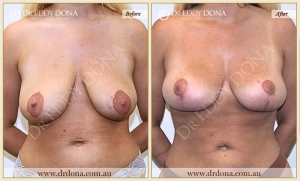Am I A Suitable Candidate for Breast Lif(Mastopexy) Surgery?
If you’re considering breast lift surgery, you should be in good physical and mental health, a non-smoker, not currently pregnant or breastfeeding and willing and able to follow post-procedure instructions to support your recovery process.
You may also need to change or pause certain medications, such as blood-thinning medications, as these can raise the risk of complications.
Additionally, you must be aware of all risks and complications associated with your surgical procedure. During your Initial Consultation, Dr Dona will discuss all aspects of the procedure with you, including all associated potential risks and complications.
Why Is A Breast Lift (Mastopexy) Required?
The primary aim of a Breast Lift is to alter the shape of the breasts without changing the breast volume (size).
Whether the breast develops in a way that the patient is unhappy with, or has changed shape over time, the surgery is designed to make the breasts appear in a way that the patient considers acceptable.
The two key elements of a Breast Lift procedure are:
- Lifting a nipple that is sitting lower than the patient is happy with
- Tightening and lifting the tissues below the nipples that are hanging relatively low and often (depending on the breast volume) sit on the abdominal wall.
Factors Determining the Right Type of Breast Lift (Mastopexy) for You
A Breast Lift (Mastopexy) is a surgical procedure that raises and reshapes the breasts by lifting the breast tissue and repositioning the nipple.
This can be performed on its own or combined with breast implants, depending on the desired result.
To determine the most appropriate Breast Lift surgery for you, there are numerous natural anatomical variables that Dr Dona must assess. Due to an individual’s pre-existing breast state, it’s often not possible to achieve the results that they may hope for. This is when, in painting a clear picture, realistic expectations are required.
Breast issues include:
Skin quality – Is the skin loose with many stretch marks or thick and firm without stretch marks? Often, the skin of someone requesting a Breast Lift has lost much of its elasticity. Thin skin that has lost its elasticity has a much greater risk of sagging again.
Degree of ptosis (sagging) – How far does the nipple need to be lifted? Is it sitting below the level of the breast fold, and by how much? The lower the nipples, the greater the difficulty in lifting and keeping them in place.
Nipple direction – Is the nipple pointing downwards or simply droopy but still pointing forwards?
Distance from the nipple to the lower breast fold – If there is a long distance, surgery could be problematic. However, if there is a very short distance, then this could be an even greater problem.
Nipple areolar size – A very large areolar size can be a potential problem with surgery.
Breast tissue quality – Is it firm or soft? Soft breast tissue is very difficult to handle and is often prone to sagging. Another critical factor to understand is that soft breast tissue will always be soft.
Nothing can be done to make soft breast tissue firm again. Surgery simply redistributes the breast tissue. Even with an implant, the breast will still be soft, and it has a much greater risk of sagging again.
Breast tissue volume – The greater the amount of natural breast tissue, the greater the degree of difficulty with the surgery. Lifting a large volume of breast tissue and aiming to keep it up is difficult and often not possible.
The more natural weight a breast has, the more that gravity is going to affect it. Additionally, the greater the amount of natural breast tissue, the more changes will occur over time.
Breast tissue attachment to the chest wall – The degree to which your breast tissue is detached from the chest wall muscle is another issue that is often difficult to explain.
Sometimes the breast tissue is very mobile with loose attachments to the underlying muscle. Effectively, your breast tissue is sliding around over your chest wall. This makes the breast tissue extremely difficult to handle and, therefore, difficult to lift effectively.
Your goals – How would you like your breasts to appear?
Time – The final variable that is impossible to predict is time. The degree to which your natural breast tissue changes after surgery is based on your genetics and personal circumstances and is impossible to know.
Often, women will achieve an excellent result early after surgery, but within a relatively short period of time, their breasts have continued to sag or change. This can be due to issues such as natural fluctuations in breast tissue volume, weight changes or hormonal changes.
When it comes to Breast Lift surgery, perhaps the hardest thing for a patient to accept is that the very reason they would like a Breast Lift is because they have weakened, soft breast skin and tissue, which has sagged.
After surgery, they still have the same skin and breast tissue, so the likelihood of repeated sagging is high.
No surgery and no surgeon can change the quality and consistency of the breast tissue and skin. All the surgeon can do is try to reposition and shape the breast tissue on that day of surgery.













